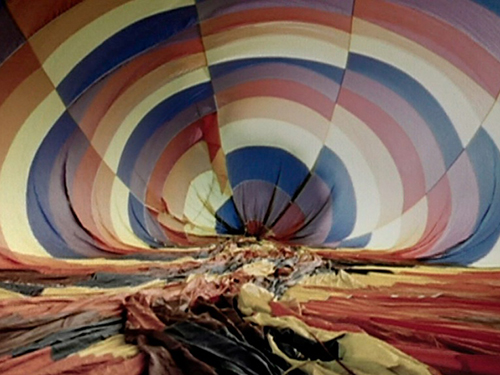
“The Last Tour is set in an imagined future world, in which tourist sites have been closed off or rendered inaccessible. A textual narration invites the viewer on a fictive expedition of the Matterhorn, including on-the-ground perspective as well as aerial views both of and within a hot-air balloon. By juxtaposing images of Disneylands Matterhorn roller coaster on images of the actual mountain, Hugonnier explores the ways in which tourism determines our experience of the landscape and reality, making each of us an explorer on a ready-made expedition.”
e-Flux1
The White Review: In your trilogy of films, Ariana, Travelling Amazonia and The Last Tour, each work investigates a different types of gaze, but they also think about failure – the failure to represent.
Marine Hugonnier: I have never been to film school, and because of that, the films I make are fragile things, they escape categories as they are the result of the way I walk through a landscape and the questions that come about as I do so. I hardly ever have their complete layout in mind before I make them – the films are always the result of an experience.
[...]
The Last Tour imagines a world where access to nature has been restricted, with certain sites closed to the public – like the Matterhorn. A tourist gets to see the mountain for the last time before it’s shut off.
The Last Tour is a completely different kind of film – it’s a science fiction short-movie. I’d read a book about the future of tourism. The last chapter of the book was set at the end of the age of spectacle, a time during which main tourist attractions would come to a complete closure. This had nothing to do with ecology; it was described as a fantasy. One of the main ideas of this book was to say: as there is nothing else to be ‘discovered’ on the surface of the earth, we are more likely to see things for the last time than the first one. I wanted to investigate the possibility of making a film without image. The viewer of the film embarks on a ‘last tour’, a hot air balloon ride around the Matterhorn. We rented a big air balloon and while we were filming, we got caught by really strong winds. We had to land in an extreme way. We were completely knocked out, and we had to be rescued by helicopters. So there’s also an element of failure in this film too, but in all three films, the failure wasn’t planned.
The space is shut down, like a crumpled map… In all three films there is a tension between restricted sight and extended sight – so the camera’s ability to show more than the eye can see, but then also the failure to represent, or the shutting down of space.
All these films are essays in which the lines between fiction and documentary are both questioned and blurred. They examine the cultural context of a particular place or subject and the politics of the imagery that I could be making. They want to investigate, question and deconstruct conventions representations. I see these films as tools for critical thinking. They are an attempt to define another kind of experience – an experience of images through the world rather than the world through images. What the work does almost on its own is to define a policy of the restriction of images, and at the same time, attempting to create a positive regime of them.
I’m interested in the idea of holes. In The Last Tour, the shut off space is called ‘a blank hole in the map’ – almost like the privatisation of space, where public access is denied. Holes are places shut off, where sight is restricted.
What I was thinking about is more like: if you create the idea of a closed-off space, then it starts to escape the realm of representation. So what is in there? What is in the emptiness? Ultimately, representation is a communicating tool. My idea, which is stated at the end of the film – and which is complete speculation – is that this blank space would help to rebuild the kingdom of the imagination. I’m not interested in holes – but rather with gaps, failure, where categories start to dissolve. When I see Gerhard Richter’s paintings, a very figurative one next to a very abstract one, I’ve always feel that it’s not the piece on the right or the piece on the left that’s interesting, but exactly what stands in the middle – the confrontation between the two.
Interview with Marine Hugonnier in The White Review2
- 1e-Flux, “Live Cinema/Marine Hugonnier: Trilogy,” 18 April 2007.
- 2Izabella Scott, “Interview with Marine Hugonnier,” The White Review, September 2015.

